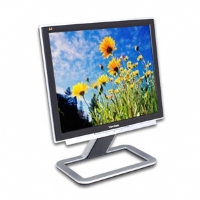Cheap Computer Monitors
What size screen should I get?

If you are going to be doing gaming or graphics, bigger is better. It’s not the only thing to consider, but it makes a big difference, as you can fit more information on the screen. Unfortunately, as with many computer parts, the price goes up exponentially as the size increases. Basically, the best value is with 15 and 17 inch monitors. If you are looking at CRT monitors, you can still get good value with 19 inch monitors.
For most applications, a 15 inch monitor will do the job. The old standard used to be 14 inch, but these have more or less dissappeared. A 17 inch monitor provides a lot more monitor space as the measurements are made from corner to corner diagonally on the monitor. A 19 inch would suit a designer using 3D graphics programs or a gamer well.
Screen resolution
A computer screen is made up of thousands of little dots, that are close enough together to form an image.

How close these dots are to each other is refered to as the Dot Pitch. With any monitor you are looking for a dot pitch that is as small as possible.
If you are looking at two similar monitors, one with a .24 dot pitch and one with a .28 dot pitch, the one with the .24 dot pitch will have crisper image than the one with .28
With LCD monitors, the typical dot pitch is .264, while as low as .24 is possible for CRT monitors. For any monitor .28 is about as low as it goes, and you should not get any less than this.
Refresh rate
Refresh rate is how fast the monitor can produce a new image on the screen.
If you are doing something where the image is changing a lot, like when gaming, then a high refresh rate is very necessary. But if doing something like typing of surfing the net, this is not needed.
Higher refresh rates give you crisper images on the screen, too.
Resolution refers to how much information can be put on the screen. If the monitor is at 800×600 it means that it is showing 800 pixels across, and 600 vertically. By using a higher resolution you can fit more things on the monitor, but it also makes them appear smaller.
While surfing the web or word processing 800×600 is fine. More common with newer computers is 1024×768. I run my 19 inch monitor at 1280×960 and I can get a lot of information on one screen. Very useful when using programs like Adobe Photoshop.
When looking at a monitor, make sure it can support above 75hz@800×600 or even better 75hz@1024×768.
Design and ergonomics
The first thing to look at is how the monitor looks. This may seem like the most obvious thing, but there are details that you should look out for.
The part that surrounds the screen should be strong and resistant to scratches. If you are going to use more than one monitor together then it’s recommended that you get a screen with as small a border as possible.
Have a look at the buttons, are they easy to operate. Along with the buttons you should have a look at the On-Screen-Display (OSD). This is used to change the physical settings of the monitor. Is it intuitive and easy to use, is it easy to adjust the settings you want to change? Have a look at these little details.
Can you adjust it’s angle? How much can you adjust it? These are smaller details but are worth looking at when investing in a monitor.









